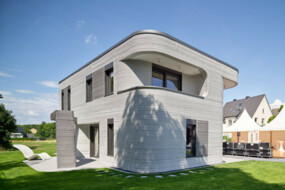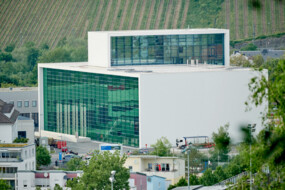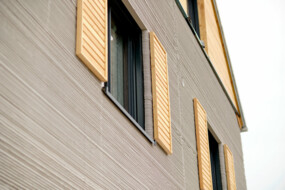A breath of fresh air in the midst of the raw materials crisis
The shortage of raw materials can be solved – also by way of deconstruction and the recycling of raw materials no longer in use. Raw materials shortages is a topic that concerns not only home-builders; the entire building industry is severely affected. In an interview, Dr. Carsten Zilg, head of R&D at Sievert, explains the measures the company is already implementing in order to counteract the shortage of raw materials to some extent.
Dr. Zilg, just how much is Sievert affected by shortages of raw materials?
Dr. Z: There are 18 Sievert mortar works in Germany. Imagine each one as an hourglass through which raw materials pass continuously. However, the diameter of the upper bulb needs to get larger and larger, because the raw materials for the plant have to be obtained from further and further away. That increases the cost of the logistics, and we have to ask ourselves the question: From where can we get more raw materials? So the shortage of raw materials is gradually creeping up on us.
To what extent has the pandemic intensified the problem of raw materials shortages?
Dr. Z: Corona has magnified the problem, has made existing issues more readily visible. Suddenly, supply chains for virtually all raw materials were disrupted, even completely interrupted. So we need to investigate this situation. In Germany we have enough deposits of sand and gravel. However, no one wants quarrying operations for these raw materials in their back gardens. It would seem that nature has to be destroyed to feed progress. But society no longer accepts that.

“The first question we asked ourselves was what happens to each raw material at the end of its life. What actually happens to all that demolished masonry, demolished infrastructure? Could we not reuse it all?“
Dr. Carsten Zilg, head of R&D at Sievert
How does your R&D Department respond to these challenges?
Dr. Z: The first question we asked ourselves was what happens to each raw material at the end of its life. What actually happens to all that demolished masonry, demolished infrastructure? Could we not reuse it all? We therefore cooperated with concrete recycling companies and others and mixed together sand and the granulate produced by such companies, e.g. the material obtained after crushing and grinding the old pavement from a motorway. We sent this material through our plant and realised that for certain products there is no adverse effect on the quality. It was also helpful that there is already a standard covering recycled concrete granulate. We were therefore able to use the approved building material and continue these tests in our plants.
Is Sievert involved in other projects that might compensate for raw materials shortages?
Dr. Z: Brick manufacturers approached us regarding another project. Misfired and cracked bricks occur in great numbers in brick production and cannot be avoided. Deconstruction also produces huge quantities of masonry rubble. We thought that if we could bind together all these broken pieces, we could create a new material again, a “cold brick” produced without any further firing. We therefore cooperated with partners and produced a mortar that can be used to bind together brick rubble in order to create a new brick with similar properties to the original. The mortar is, on the one hand, a cast stone and, on the other, up to 40% of it is made up of clay bricks. In the next step of this project, our brickwork partners will set up a pilot plant for this new technology where several tens of thousands of tonnes of brickwork rubble can be recycled to form new masonry units. Sievert would supply the binder in the form of premixed dry mortar.
Recycled concrete and cold bricks – those must be welcome solutions when it comes to sustainability. What are the production challenges?
Dr. Z: It is mainly others who have expressed concerns, which, however, helps us to improve the products. For example, we heard the following from a works manager: “The recycled concrete granulate is quite angular. What effect does have that have on my production plant? Does that not result in greater wear?” And an applications engineer said: “The mortar has to be more malleable to apply it better.” However, at Sievert we have such a concentration of building materials expertise that we can apply targeted solutions to compensate for such disadvantages. In cold brick production, achieving the compressive strength of the original brick is just one of the challenges. Therefore, the binder must form a homogeneous structure together with the brick rubble in order to achieve that compressive strength. Of course, there is much detailed work involved here, the project took three years.

Cold brick made from recycled brick rubble
Does this new method mean that customers can look forward to savings despite the shortages of raw materials?
Dr. Z: Well, look at it this way, when oil costs, let’s say, 50 dollars a barrel, no one is interested in wind turbines. But when oil costs more than 100 dollars a barrel, then wind energy suddenly becomes interesting. When the raw materials in the building industry become more expensive, then we can work with solutions and materials that no one used in the past because they were too expensive. The rising cost of dealing with carbon emissions and other costs related to environmental issues shifts the framework, which leads to raw materials that are a drain on resources being removed from premixed dry mortar formulas and replaced by secondary raw materials, for example.
How are innovations from Sievert already helping to alleviate the shortages of raw materials?
Dr. Z: The cold brick is just one example of how new premixed dry mortar formulas can supply more ecologically beneficial products for the building industry. However, we will increase the proportion of secondary raw materials in premixed dry mortar formulas as well. We are already using ground granulated blast-furnace slag, a by-product of steel making, for glass beads from the recycling of old bottles and glass. Recycled concrete granulate is one of the major topics we are already looking into. Besides closing material cycles on the raw material side and expanding the range of premixed dry mortar formulas, which reduce the impact of construction processes and increase the energy efficiency of buildings, we are also looking at the ecological footprint of our own production processes. In production there are secondary flows we want to avoid disposing of. One solution for this would be to separate premixed dry mortar formulas into their constituent materials again so that these mono-fractions can be reused. That has already been tried out successfully on a pilot scale for recovering sand. In future we shall use this method in all our plants.
„Everyone wants to build, but no one wants to spoil nature to obtain the raw materials.“
Dr. Zilg, is taking the sustainability route the way out of the shortage of raw materials?
Dr. Z: The answer to that is quite simply the circular economy. Legislators have realised that raw materials are finite. But once again, the social acceptance aspect is important. No one wants a rubbish dump on their doorstep, so the authorities are not happy about issuing new permits. In some regions, landfill capacity is now less than 10 years. We are responding to this. We must always organise our business activities so that they are socially acceptable. Everyone wants to build, but no one wants to spoil nature to obtain the raw materials. This is understandable, but sets the bar very high when it comes to devising new solutions through research. Up until now we’ve always found a solution, but there have been plenty of sleepless nights!



